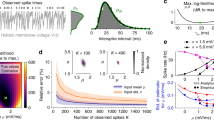Abstract
Neuron models, in particular conductance-based compartmental models, often have numerous parameters that cannot be directly determined experimentally and must be constrained by an optimization procedure. A common practice in evaluating the utility of such procedures is using a previously developed model to generate surrogate data (e.g., traces of spikes following step current pulses) and then challenging the algorithm to recover the original parameters (e.g., the value of maximal ion channel conductances) that were used to generate the data. In this fashion, the success or failure of the model fitting procedure to find the original parameters can be easily determined. Here we show that some model fitting procedures that provide an excellent fit in the case of such model-to-model comparisons provide ill-balanced results when applied to experimental data. The main reason is that surrogate and experimental data test different aspects of the algorithm’s function. When considering model-generated surrogate data, the algorithm is required to locate a perfect solution that is known to exist. In contrast, when considering experimental target data, there is no guarantee that a perfect solution is part of the search space. In this case, the optimization procedure must rank all imperfect approximations and ultimately select the best approximation. This aspect is not tested at all when considering surrogate data since at least one perfect solution is known to exist (the original parameters) making all approximations unnecessary. Furthermore, we demonstrate that distance functions based on extracting a set of features from the target data (such as time-to-first-spike, spike width, spike frequency, etc.)—rather than using the original data (e.g., the whole spike trace) as the target for fitting—are capable of finding imperfect solutions that are good approximations of the experimental data.
Similar content being viewed by others
References
Achard P, De Schutter E (2006) Complex parameter landscape for a complex neuron model. PLoS Comput Biol 2: e94
Adiga NR, Almasi G, Almasi GS, Aridor Y, Barik R, Beece D, Bellofatto R, Bhanot G, Bickford R, Blumrich M, et al (2002) An Overview of the BlueGene/L Supercomputer. Paper presented at: Supercomputing, ACM/IEEE 2002 Conference
Bäck T, Fogel DB, Michalewics Z (1998) Handbook of evolutionary computation. Institute of Physics Publishing, Bristol
Bush K, Knight J, Anderson C (2005) Optimizing conductance parameters of cortical neural models via electrotonic partitions. Neural Netw 18: 488–496
Carnevale NT, Hines ML (2005) The NEURON book. Cambridge University Press, Cambridge
Cohon JL (1985) Multicriteria programming: Brief review and application. In: Gero JS (eds) Design optimization. Academic Press, New York
Deb K, Pratap A, Agarwal S, Meyarivan T (2002) A fast and elitist multiobjective genetic algorithm: NSGA-II. IEEE Trans Evol Comput 6: 182–197
Druckmann S, Banitt Y, Gidon A, Schuermann F, Markram H, Segev I (2007) A novel multiple objective optimization framework for constraining conductance-based neuron models by experimental data. Front Neurosci 1: 7–18
Gerken WC, Purvis LK, Butera RJ (2006) Genetic algorithm for optimization and specification of a neuron model. Neurocomputing 69: 1039–1042
Hobbs KH, Hooper SL (2008) Using complicated, wide dynamic range driving to develop models of single neurons in single recording sessions. J Neurophysiol 99: 1871–1883
Holland JH (1975) Adaptation in natural and artificial systems : an introductory analysis with applications to biology, control, and artificial intelligence. University of Michigan Press, Ann Arbor
Hwang CL, Masud ASM (1979) Multiple objective decision making, methods and applications : a state-of-the-art survey. Springer, Berlin
Keren N, Peled N, Korngreen A (2005) Constraining compartmental models using multiple voltage recordings and genetic algorithms. J Neurophysiol 94: 3730–3742
LeMasson G, Maex R (2001) Introduction to equation solving and parameter fitting. In: De Schutter E (eds) Computational Neuroscience: Realistic Modeling for Experimentalists. CRC Press, London, pp 1–21
Markram H, Lubke J, Frotscher M, Roth A, Sakmann B (1997) Physiology and anatomy of synaptic connections between thick tufted pyramidal neurones in the developing rat neocortex. J Physiol 500(Pt 2): 409–440
Prinz AA, Billimoria CP, Marder E (2003) Alternative to hand-tuning conductance-based models: construction and analysis of databases of model neurons. J Neurophysiol 90: 3998–4015
Vanier MC, Bower JM (1999) A comparative survey of automated parameter-search methods for compartmental neural models. J Comput Neurosci 7: 149–171
Weaver CM, Wearne SL (2006) The role of action potential shape and parameter constraints in optimization of compartment models. Neurocomputing 69: 1053–1057
Author information
Authors and Affiliations
Corresponding author
Rights and permissions
About this article
Cite this article
Druckmann, S., Berger, T.K., Hill, S. et al. Evaluating automated parameter constraining procedures of neuron models by experimental and surrogate data. Biol Cybern 99, 371–379 (2008). https://doi.org/10.1007/s00422-008-0269-2
Received:
Accepted:
Published:
Issue Date:
DOI: https://doi.org/10.1007/s00422-008-0269-2




